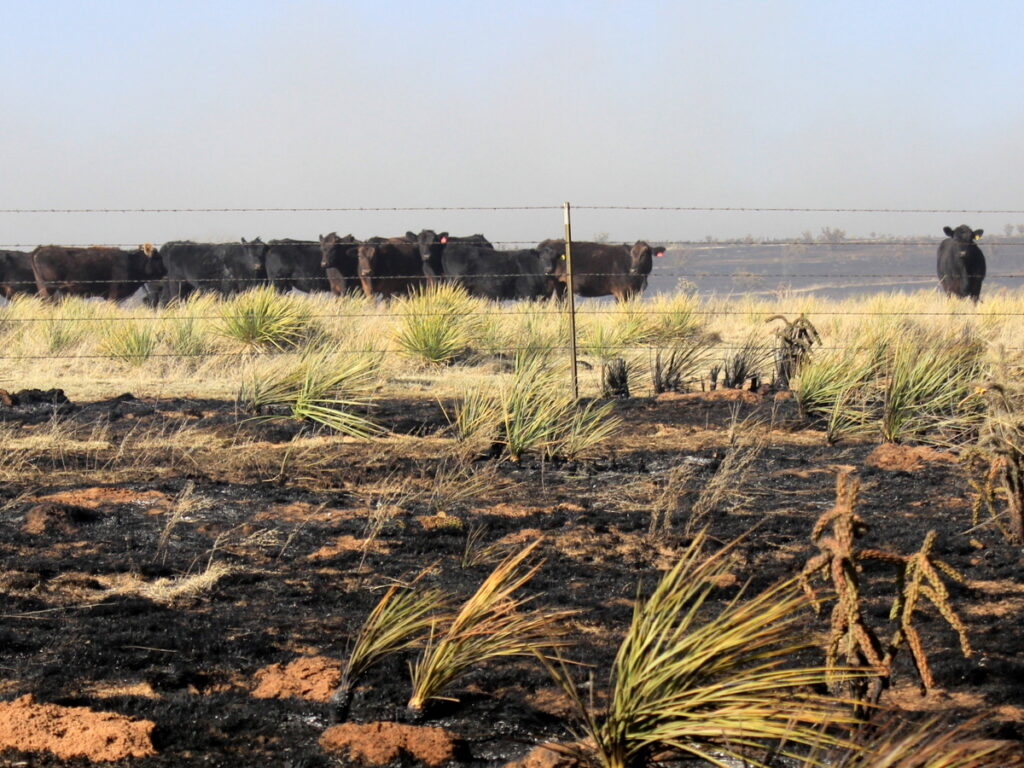Wildfires can destroy crops and be devastating to cattle ranchers if livestock is not evacuated in time. As your land begins to recover, ensure effective pasture and cattle management:
Pasture management
Stop grazing for a minimum of one grazing season to allow vegetation time to recover. This will:
- Maintain and improve plant health and productivity.
- Reestablish vegetation that can reduce soil erosion.
- Develop shelter and nesting habitat for birds.
- Allow for production to help wildlife.
- Provide shelter for deer, reducing predation.
- Reduce the potential for toxic plant consumption by cattle.
Grazing too soon after the fire can slow these processes and delay the time needed for full recovery. Defer any grazing until after mid-July if it is necessary to graze during the first growing season.
Other tips:
- Base the number of cattle on the amount of forage available. Do not plan to return to customary stocking rates for two growing seasons. Recovery may be more rapid than this, but plan conservatively.
- Use a grazing system that postpones using the burned area, if unburned pasture remains.
- Minimize impacts of overgrazing on unburned areas.
- Realize that broad-leaved plants (forbs or weeds) have a place. These plants provide food and protect soil and wildlife. Avoid the temptation to spray them.
- Hold off on brush control. Post-fire is a good time to treat prickly pear but defer decisions on other brush species. Be sure to observe treatment timing and recommendations for herbicide treatment within Houston toad habitat.
Cattle management
When deciding to cull or feed and maintain cattle, keep in mind the timeframe of rangeland recovery. At least four months, ideally seven months, will be needed before the burned range can be partially restocked.
- Cull cattle based on age, productivity, and cost of maintaining productivity.
- Maintain adequate nutrition to support milk production and reproduction.
- Depending on the time of year cows are calving and environmental conditions affecting vegetation growth, it might be necessary to provide supplemental nutrients. Consult with your local AgriLife Extension office and licensed veterinarian for more detailed information.
- Poor quality roughage will require supplemental protein and energy.
- Overstocking unburned areas can reduce cattle performance and increase supplemental feed requirements.
- Incorporate labor, replacement of fencing/equipment, and equipment costs into all evaluations of feeding programs.
- Continue to evaluate cattle for latent effects of the fire like foot and respiratory problems.
- Evaluate calves for signs of inadequate milk consumption.
- Evaluate early weaning as a possibility to reduce feed requirements of cows.
- Cull cows with fire damage before they completely lose value.
Fencing and facilities
Be aware of opportunities to change fencing layouts and types.
Evaluate fence line layout for improved grazing management, livestock movement, and wildlife benefits. Don’t assume an old fence should go back to its original spot. This is a good opportunity to put them in the best location.
Get assistance
Contact your local county AgriLife Extension agent if you need more technical help. Visit Funding Connector to explore grants that might be available. Also, see After the Fire Landowner Financial Assistance for more information.
